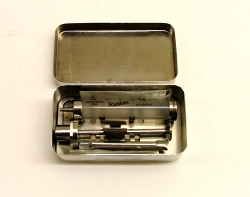A Healthy Start - Health Promotion
 Image left: Glass syringe with reversible needle, c.1960s DUNUC 9187
Image left: Glass syringe with reversible needle, c.1960s DUNUC 9187
One of the primary aims of the NHS is to promote good health. An early example of this came with the introduction of polio vaccinations in 1956, which led to an immediate and dramatic reduction in the disease. Children are now routinely vaccinated against ten infectious diseases, and older people against flu. There have been vaccine scares with whooping cough and MMR, and we can expect more in the future as people expect safe products to protect their health.
When the contraceptive pill was introduced in 1961, it was strictly for married women only. By the mid-60s, engaged couples became eligible up to eight weeks before the wedding, but only on production of a wedding dress receipt or letter from the minister! Sexual freedom came to single women in 1967, and formal provision of free contraceptive advice and family planning services for all arrived in 1974. Meanwhile the Abortion Act was introduced by David Steel in 1968, making back-street terminations a thing of the past.
The mid-1980s saw a major campaign to educate people about the threat of HIV / AIDS. It set out to shock with images of tombstones and icebergs, and a household leaflet warned “Don’t die of ignorance”. At the time there were tremendous fears about how to mix with and care for people infected with the virus.
With malignant melanoma showing the fastest rise in incidence of any cancer in white-skinned people, sun awareness campaigns were introduced in 1993 to raise awareness of the risks of skin cancer. NHS breast and cervical cancer screening programmes were launched in 1988, joined recently by bowel cancer screening, and 2008 has seen the human papilloma virus vaccine against cervical cancer offered to teenage girls.